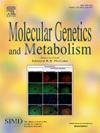Natural history progression of MRI brain volumetrics in type II late-infantile and juvenile GM1 gangliosidosis patients
IF 3.7
2区 生物学
Q2 ENDOCRINOLOGY & METABOLISM
引用次数: 0
Abstract
Objective
GM1 gangliosidosis is a rare lysosomal storage disorder characterized by the accumulation of GM1 gangliosides in neuronal cells, resulting in severe neurodegeneration. Currently, limited data exists on the brain volumetric changes associated with this disease. This study focuses on the late-infantile and juvenile subtypes of type II GM1 gangliosidosis, aiming to quantify brain volumetric characteristics to track disease progression.
Methods
Brain volumetric analysis was conducted on 56 MRI scans from 24 type II GM1 patients (8 late-infantile and 16 juvenile) and 19 healthy controls over multiple time points. The analysis included the use of semi-automated segmentation of the whole brain, ventricles, cerebellum, corpus callosum, thalamus, caudate, and lentiform nucleus. A generalized linear model was used to compare the volumetric measurements between the patient groups and healthy controls, accounting for age as a confounding factor.
Results
Both late-infantile and juvenile GM1 patients exhibited significant whole-brain atrophy compared to healthy controls, even after adjusting for age. Notably, the late-infantile subtype displayed more pronounced atrophy in the cerebellum, thalamus, and corpus callosum compared to the juvenile subtype. Both late-infantile and juvenile subtypes showed significantly higher ventricular volumes and a significant reduction in all other structure volumes compared to the healthy controls. The volumetric measurements also correlated well with disease severity based on clinical metrics.
Conclusions
The findings underscore the distinct brain volumetrics of the late-infantile and juvenile subtypes of GM1 gangliosidosis compared to healthy controls. These quantifications can be used as reliable imaging biomarkers to track disease progression and evaluate responses to therapeutic interventions.
求助全文
约1分钟内获得全文
求助全文
来源期刊

Molecular genetics and metabolism
生物-生化与分子生物学
CiteScore
5.90
自引率
7.90%
发文量
621
审稿时长
34 days
期刊介绍:
Molecular Genetics and Metabolism contributes to the understanding of the metabolic and molecular basis of disease. This peer reviewed journal publishes articles describing investigations that use the tools of biochemical genetics and molecular genetics for studies of normal and disease states in humans and animal models.
 求助内容:
求助内容: 应助结果提醒方式:
应助结果提醒方式:


